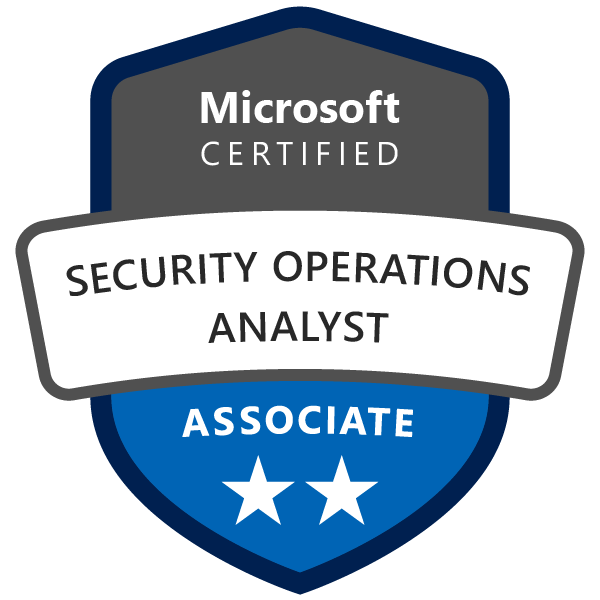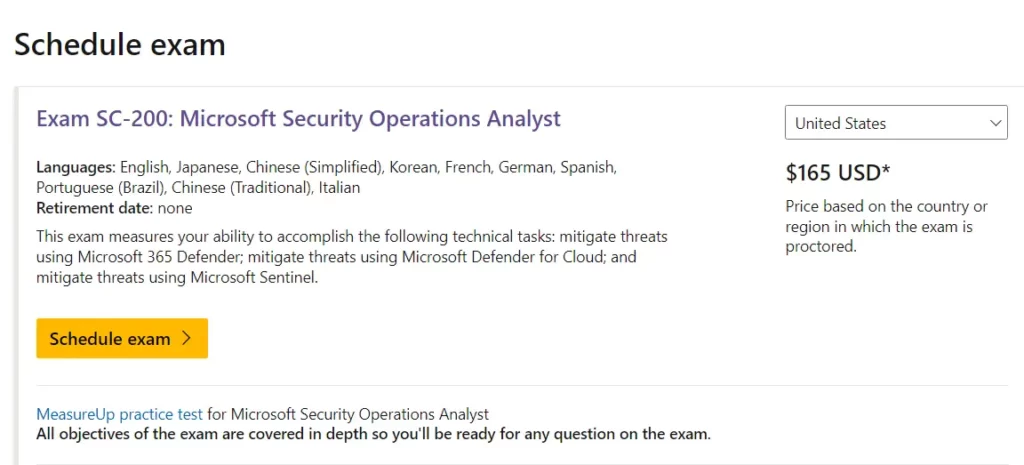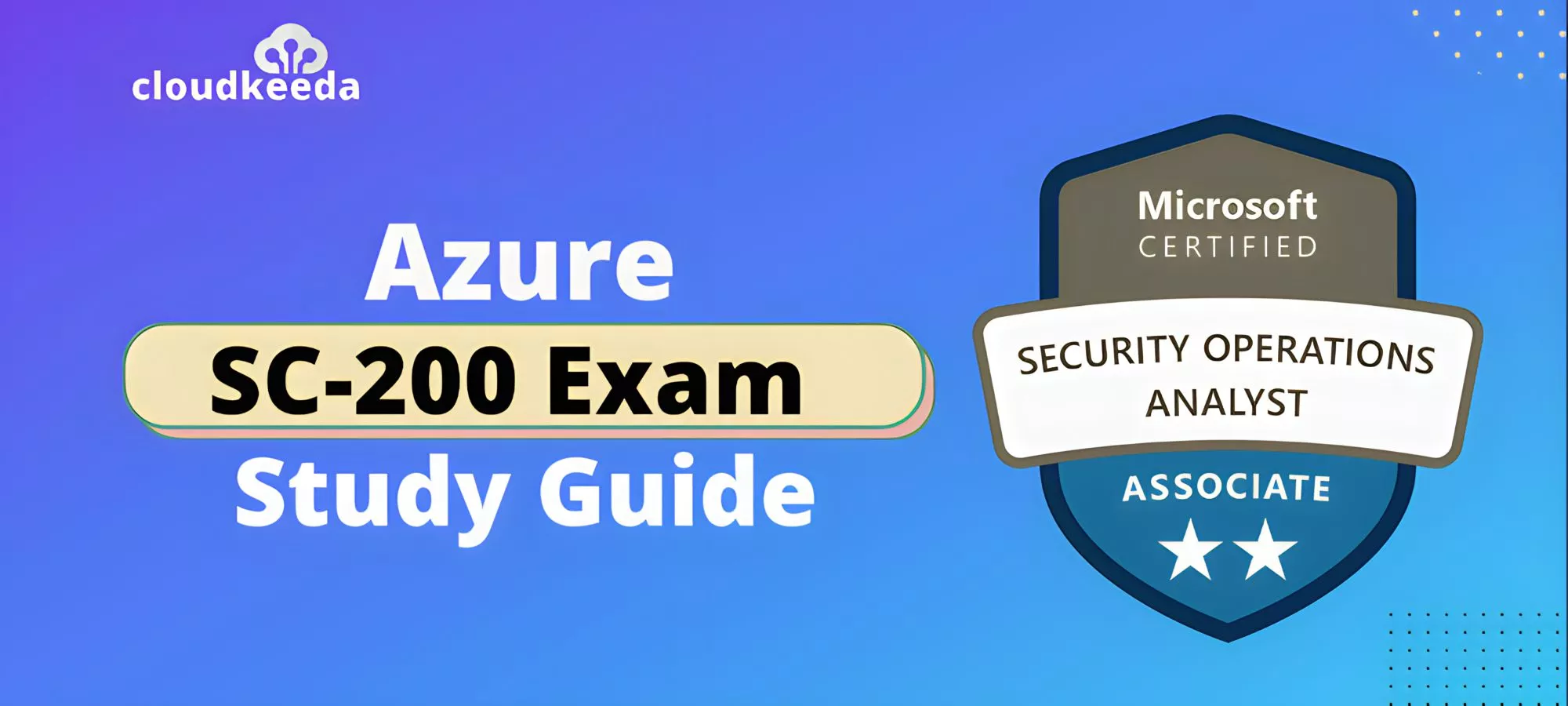The Microsoft SC-200 certification validates a candidate’s knowledge and skills in operations security.
These certifications are suitable for cloud administrators, IT professionals, security administrators, Microsoft security administrators, and network administrators who ensure the security of their organization’s information technology systems.
Using various security solutions, Microsoft Security Operations Analysts monitor and respond to threats, identify and resolve active attacks, and advise on threat protection practices.
Obtaining the SC-200 certification can lead to career advancement opportunities, increased earnings, and a deeper understanding of operations security.
SC-200 is a valuable credential for IT professionals who want to demonstrate their expertise in Microsoft operations security.
Table of Contents
SC-200 Certification Overview
The SC-200 is an associate-level certification that covers operations security. Once you pass this Microsoft exam, you’ll get the Microsoft Certified Security Operations Analyst Associate certification.
Microsoft Security Operations Analyst (SC-200) tests your ability to defend against threats using Microsoft 365 Defender, Azure Defender, and Azure Sentinel.
A Microsoft Security Operations Analyst protects the company’s IT infrastructure with business partners. They are responsible for ensuring that the organization’s information security is maintained.

Are you new to Azure Cloud? Do check out our blog post on the Microsoft Azure Certification Path 2023 and choose the best certification for you.
Ace the SC-200: Microsoft Security Operations Analyst Exam with flying colors using this proven practice test. Enroll Now and accelerate your path to success!
Who Is Microsoft Security Operations Analyst?
Microsoft security operations analysts collaborate with organizational stakeholders to ensure the security of information technology systems.
As part of their responsibility, they rapidly resolve active attacks and advise on the improvement of threat protection practices. And refer violations of organizational policies to relevant stakeholders.
They use a variety of security solutions across their environment to manage threats, monitor and respond.
In this role, they investigate, respond to, and hunt for threats using Microsoft Sentinel, Microsoft Defender for Cloud, Microsoft 365 Defender, and third-party security products.
Who Is This Certification For?
The certification is for:
- Cloud Administrator
- IT Professional
- IT Security Professional
- Microsoft Security Administrators
- Network Administrators
Why SC-200 Certification
There are many benefits to earning Microsoft certifications, which is why their popularity has grown dramatically recently:
- With this certification, threats are managed, tracked, and responded to within their environment.
- This certification gives an in-depth understanding of operations security.
- The SC-200 certification improves your understanding of Microsoft Azure Sentinel and Azure Defender.
- This credential validates your security knowledge.
- Additionally, it shows a commitment to lifelong learning.
- Your career will advance and your salary will rise.
- For organizations searching for operations security, it adds value.
- You will gain an understanding of Microsoft 365 Defender, Azure Defender, and Azure Sentinel.
- It opens doors since security is a top priority in business.
- In the job market, it keeps you ahead of the competition.
Microsoft Security Operations Analyst Responsibilities
- Microsoft Security Operations Analysts are responsible for delivering secure information technology systems to an organization. It is important that they work with organizational stakeholders to accomplish this goal.
- They identify violations of organizational policies and, by reporting them, decrease risk by promptly identifying and correcting active attacks in the environment.
- Providing advice on how to enhance threat protection activities is one of their responsibilities.
- Microsoft Security Operations Analysts are also responsible for monitoring, threat management, and response by utilizing various security solutions.
- They conduct threat hunting with Microsoft 365 Defender, Azure Security Centre, Azure Defender, Azure Sentinel, and third-party products.
Check Out: Top 10 Microsoft Azure Security Best Practices
SC-200 Exam Details
Exam Name SC-200: Microsoft Security Operations Analyst | Passing Marks 700 |
Exam Fee $165 | Exam Duration 120 Minutes |
Exam Validity 1 Year | Exam Languages English, Japanese, Chinese (Simplified), Korean, French, German, Spanish, Portuguese (Brazil), Chinese (Traditional), Italian |
Total Questions 40-60 Questions | Exam Type Multiple-choice and Multiple response questions |
SC-200 Exam Skills Measured
Mitigate threats using Microsoft 365 Defender | 25-30% |
Mitigate threats using Microsoft Defender for Cloud | 20-25% |
Mitigate threats using Microsoft Sentinel | 50-55% |
How to Register for SC 200 Certification Exam
You can register for the Microsoft Security Operations Analyst Exam (SC-200) by going to the Official Microsoft Page.

Prerequisite for SC-200 Certification
SC-200 certification prerequisites include:
- The basics of Microsoft 365 Defender
- Understanding of Microsoft security, compliance, and identification products.
- A working understanding of Windows 10/11
- Understanding of Azure services, including Azure SQL
- The ability to create, deploy and manage virtual machines on Azure.
- Knowledge of scripting concepts.
SC-200 Study Guide
Mitigate threats using Microsoft 365 Defender (25–30%)
Mitigate threats to the productivity environment by using Microsoft 365 Defender
- Investigate, respond, and remediate threats to Microsoft Teams, SharePoint, and OneDrive
- Investigate, respond, and remediate threats to email by using Microsoft Defender for Office 365
- Investigate and respond to alerts generated from Data Loss Prevention policies
- Investigate and respond to alerts generated from insider risk policies
- Identify, investigate, and remediate security risks by using Microsoft Defender for Cloud Apps
- Configure Microsoft Defender for Cloud Apps to generate alerts and reports to detect threats
Mitigate endpoint threats by using Microsoft Defender for Endpoint
- Manage data retention, alert notification, and advanced features
- Data Retention
- Alert notifications
- Advanced features
- Recommend security baselines for devices
- Respond to incidents and alerts
- Manage automated investigations and remediations
- Assess and recommend endpoint configurations to reduce and remediate vulnerabilities by using the Microsoft’s threat and vulnerability management solution
- Manage endpoint threat indicators
Mitigate identity threats
- Identify and remediate security risks related to events for Microsoft Azure Active Directory (Azure AD), part of Microsoft Entra
- Identify and remediate security risks related to Azure AD Identity Protection events
- Identify and remediate security risks related to Azure AD Conditional Access events
- Identify and remediate security risks related to Active Directory Domain Services using Microsoft Defender for Identity
Manage extended detection and response (XDR) in Microsoft 365 Defender
- Manage incidents across Microsoft 365 Defender products
- Manage investigation and remediation actions in the Action Center
- Perform threat hunting
- Identify and remediate security risks using Microsoft Secure Score
- Analyze threat analytics
- Configure and manage custom detections and alerts
Mitigate threats using Microsoft Defender for Cloud (20–25%)
Implement and maintain cloud security posture management and workload protection
- Plan and configure Microsoft Defender for Cloud settings, including selecting target subscriptions and workspaces
- Configure Microsoft Defender for Cloud roles
- Assess and recommend cloud workload protection
- Identify and remediate security risks using the Microsoft Defender for Cloud Secure Score
- Manage policies for regulatory compliance
- Review and remediate security recommendations
Plan and implement the use of data connectors for ingestion of data sources in Microsoft Defender for Cloud
- Identify data sources to be ingested for Microsoft Defender for Cloud
- Configure automated onboarding for Azure resources
- Connect multi-cloud and on-premises resources
- Configure data collections
Configure and respond to alerts and incidents in Microsoft Defender for Cloud
- Validate alert configuration
- Set up email notifications
- Create and manage alert suppression rules
- Design and configure workflow automation in Microsoft Defender for Cloud
- Remediate alerts and incidents by using Microsoft Defender for Cloud recommendations
- Manage security alerts and incidents
- Analyze Microsoft Defender for Cloud threat intelligence reports
- Manage user data discovered during an investigation
Mitigate threats using Microsoft Sentinel (50–55%)
Design and configure a Microsoft Sentinel workspace
- Plan a Microsoft Sentinel workspace
- Configure Microsoft Sentinel roles
- Design and configure Microsoft Sentinel data storage
- Implement and use Content hub, repositories, and community resources
Plan and implement the use of data connectors for ingestion of data sources in Microsoft Sentine
- Identify data sources to be ingested for Microsoft Sentinel
- Identify the prerequisites for a Microsoft Sentinel data connector
- Configure and use Microsoft Sentinel data connectors
- Configure Microsoft Sentinel data connectors by using Azure Policy
- Configure Microsoft Sentinel connectors for Microsoft 365 Defender and Microsoft Defender for Cloud
- Design and configure Syslog and CEF event collections
- Design and configure Windows Security event collections
- Configure custom threat intelligence connectors
Manage Microsoft Sentinel analytics rules
- Design and configure analytics rules
- Activate Microsoft security analytics rules
- Configure built-in scheduled queries
- Configure custom scheduled queries
- Define incident creation logic
- Manage and use watchlists
- Manage and use threat indicators
Perform data classification and normalization
- Classify and analyze data by using entities
- Create custom logs in Azure Log Analytics to store custom data
- Query Microsoft Sentinel data by using Advanced SIEM Information Model (ASIM) parsers
- Develop and manage ASIM parsers
Configure Security Orchestration, Automation, and Response (SOAR) in Microsoft Sentinel
- Configure automation rules
- Create and configure Microsoft Sentinel playbooks
- Configure alerts and incidents to trigger automation
- Use automation to remediate threats
- Use automation to manage incidents
Manage Microsoft Sentinel incidents
- Triage incidents in Microsoft Sentinel
- Investigate incidents in Microsoft Sentinel
- Respond to incidents in Microsoft Sentinel
- Investigate multi-workspace incidents
- Identify advanced threats with User and Entity Behavior Analytics (UEBA)
Use Microsoft Sentinel workbooks to analyze and interpret data
- Activate and customize Microsoft Sentinel workbook templates
- Create custom workbooks
- Configure advanced visualizations
- View and analyze Microsoft Sentinel data using workbooks
- Track incident metrics using the security operations efficiency workbook
Hunt for threats using Microsoft Sentinel
- Create custom hunting queries
- Run hunting queries manually
- Monitor hunting queries by using Livestream
- Configure and use MSTICPy in notebooks
- Perform hunting by using notebooks
- Track query results with bookmarks
- Use hunting bookmarks for data investigations
- Convert a hunting query to an analytical rule
SC-200 Exam Retake Policy
- If the candidate does not achieve the passing score, he/she must wait 24 hours before reapplying.
- A candidate can reschedule their exam from their certificate dashboard.
- A candidate can reappear for the examination only five times.
- A candidate will have another chance after 14 days if it fails the second time.
- The fourth and fifth attempts will also require 14 days of waiting.
Conclusion
Microsoft SC-200 certification is a valuable credential for security administrators, network administrators, and IT professionals. This certification validates your security knowledge and helps you better understand Microsoft 365 Defender, Azure Defender, and Azure Sentinel.
Earning the SC-200 certification can help you advance your career, earn more money, and demonstrate your commitment to learning.
In addition to monitoring, managing, and responding to threats using a variety of security tools, Microsoft Security Operations Analysts play an essential role in the security of their organization’s IT infrastructure.
Adding value to operations security with SC-200 certification will keep you ahead of the competition in the job market.
FAQs
Q1. Who should take SC-200?
Cloud administrators, IT Professionals, IT Security Professionals, Microsoft Security Administrators, and Network Administrators should take SC-200.
Q2. How long is SC 200 valid?
SC- 200 certifications will remain valid for two years.
Q3. How many questions are on the SC 200 exam?
The Microsoft SC-200 exam has 40-60 questions. Questions include mark reviews, multiple-choice, build lists, case studies, and more.
Q4. Is it easy to pass SC-200?
You may not pass the SC-200 certification exam if you only prepare half-heartedly. Preparing for the SC-200 begins with a commitment to study.

